


This small vegan lemon drizzle cake packs a big flavor. Optional pomegranate seeds add a tart crunch as well as a festive appearance. It can be soy-free or nut-free depending on the type of milk or yogurt you use.
It’s been a while, almost 2 1/2 years, since I’ve updated this blog. I’ve been working behind the scenes, answering email, posting on Facebook sometimes, updating the software, and paying the monthly bills (though I did miss one and had the blog disappear for a few hours until someone let me know.) But coming up with a new recipe has been the one thing I haven’t been able to do.
There are multiple reasons why. I recently restarted my newsletter and shared a few of the big changes in my life with my subscribers, and if you’re interested, you can read the email here, without having to sign up for a subscription. In my last email, I updated a recipe I nicknamed Food in a Bowl and promised a new Christmas recipe. Today I am happy to deliver on that promise.
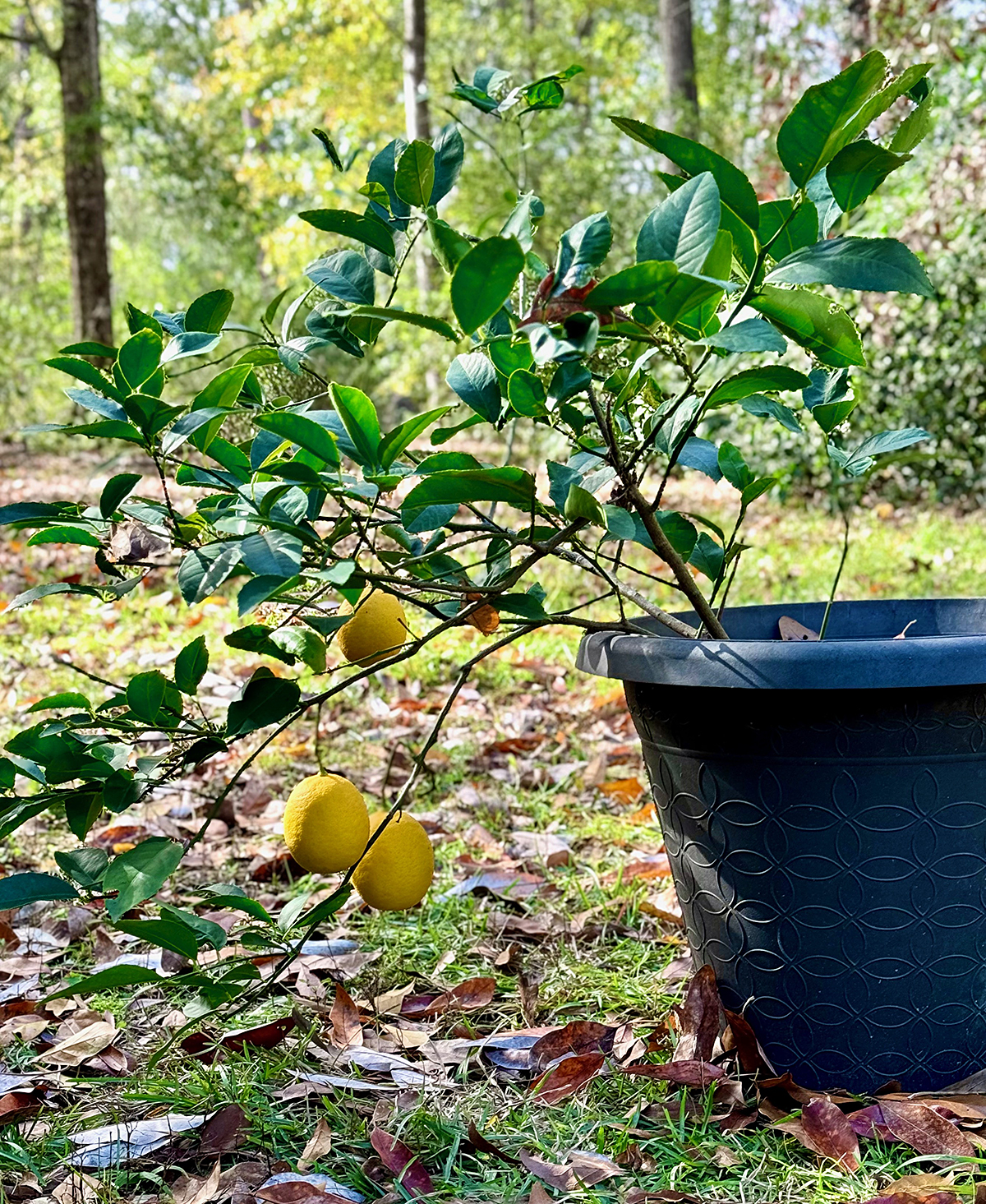
The Little Lemon Tree That Could, leaning from the weight of 3 lemons
Last winter we had a freeze so bad that it killed several of my parents’ citrus trees and killed back all but a few shoots on their huge old lemon tree; it won’t be producing lemons this year, if ever again. Then this summer’s drought took out even more of their citrus, despite my 87-year old mother working daily to keep them watered.
All of our plants suffered in that drought, but The Little Lemon Tree That Could surprised us. It produced fragrant flowers in early spring, and we didn’t notice that a few had developed into lemons until mid-drought. I kept it watered after that and was amazed when we had three full-sized Meyer lemons by fall. They became so heavy that they made the tree grow sideways.
They’ve just ripened enough to pick (the little tree sprang back in relief as I cut them), and I wanted to use them in something special, so I started working out a recipe for an oil-free lemon drizzle cake. My first attempt had great flavor but the cake itself was dense and “claggy,” as the judges on Bake Off would say. I realized in reworking the recipe that I’d used too much soy yogurt, so I adjusted the recipe and made it again with success. The cake was now light and airy.
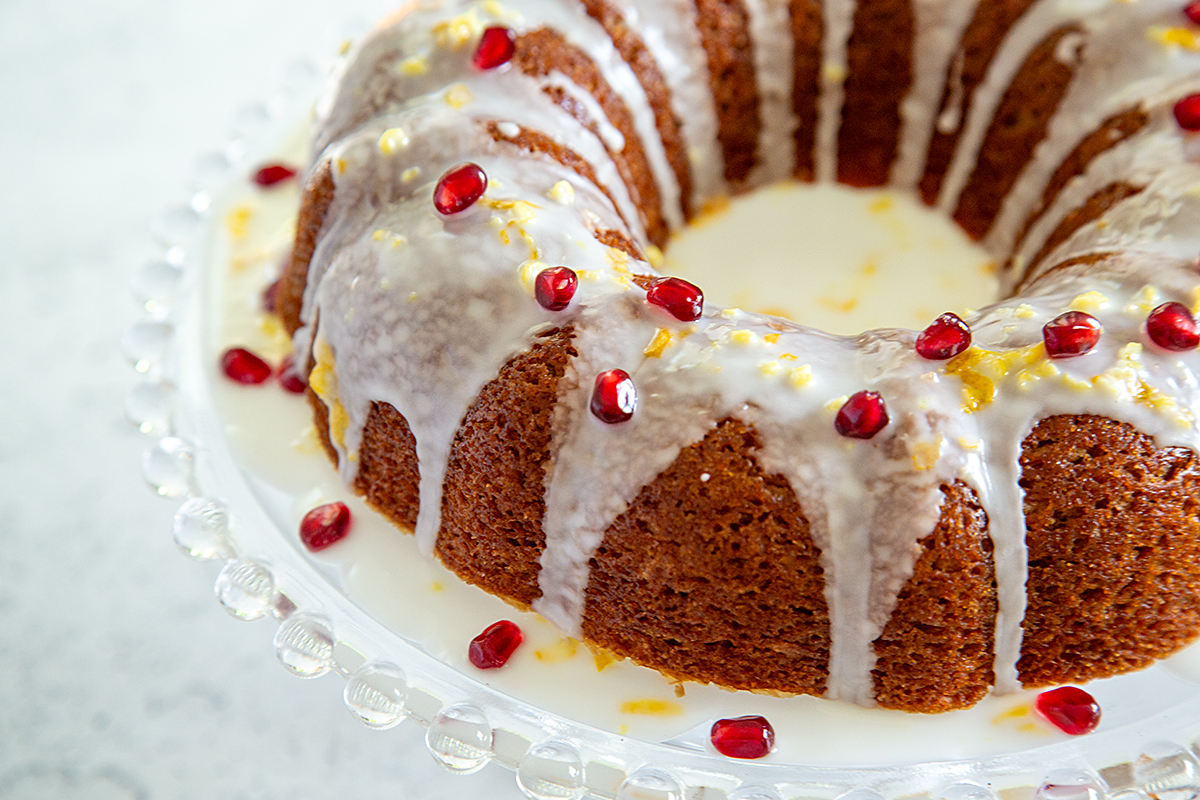
The first time I made it, I used the traditional drizzle icing that’s made with granulated sugar and lemon juice. It partially sinks into the cake and partly forms a crunchy coating on top. But it’s not as decorative as a confectioner’s sugar icing, so the second time, for the cameras, I used the white glaze. Friends, I liked the original glaze better. Powdered sugar in large amounts is not tasty to me, so from now on, I’ll make it with the traditional glaze. You’ll find instructions for it in the recipe’s notes.
And there will be a next time. My husband has declared this his new favorite cake.
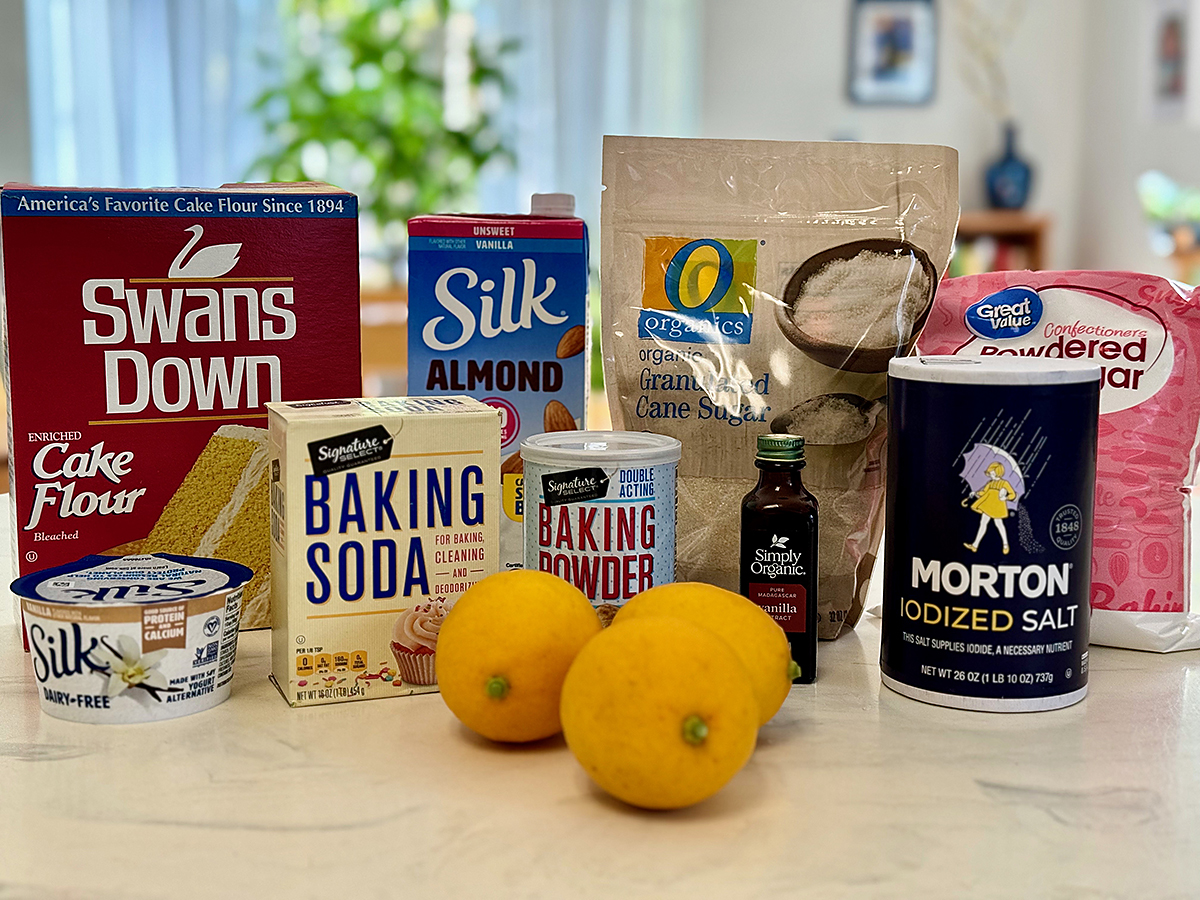
This is such an easy cake to make, but as with all cakes, following the recipe exactly will yield the best results. Here are a few important things to keep in mind.
I developed the recipe using cake flour, which is made from soft wheat and has less protein than all-purpose flour and whole wheat flour. It also has a finer grain, and it makes cakes lighter and fluffier than other flours. If you substitute one of them, your cake will have a coarser texture, and you may need to adjust the amount of liquid you add.
I used organic sugar and almond milk, which made my cake more tan than white. (The vanilla soy yogurt probably added color, too.) White sugar and coconut milk should make a much more bright cake interior.
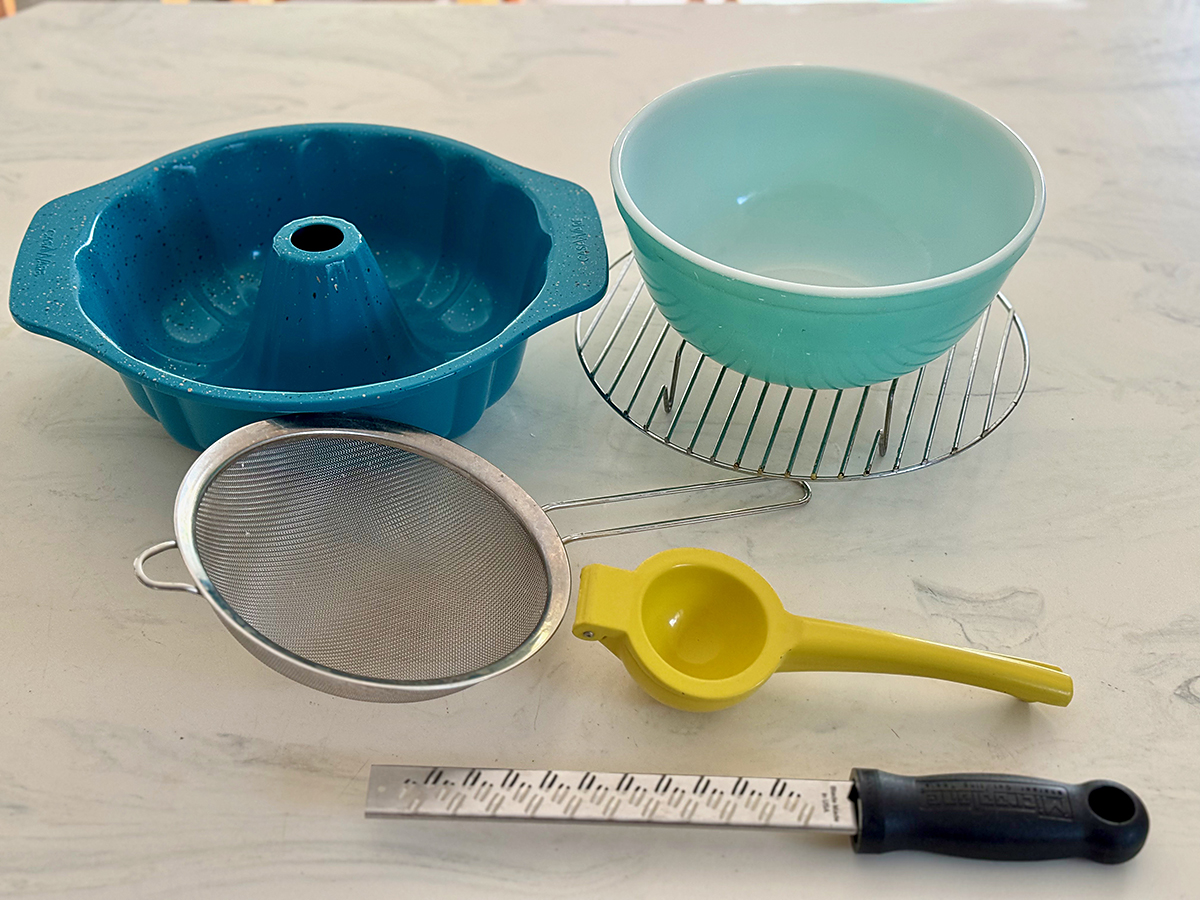
Some essential equipment you will need: A 10-12 cup non-stick Bundt pan, a rack to cool the cake on, and a lemon squeezer or other type of juicer. It’s possible to make the cake in a 9-inch round or square cake pan, but it will take longer than the 30-40 minutes specified in the recipe. A wire rack is essential for cooling the cake without it becoming moist on the bottom.
I recommend sifting the flour with the dry ingredients for two reasons: to remove any lumps and to more thoroughly mix the ingredients together. If you’ve ever bit into a lump of baking soda in a piece of cake, you’ll always sift your dry ingredients. You can use a sifter or any fine strainer or sieve. (Amazon links are affiliate links. I earn a commission on qualified purchases.)
There are all sorts of tools for zesting a lemon; I sometimes just use a knife and then chop the peel up finely. This time I used a microplane that’s technically for shaving chocolate and carrots, but it grates fast in both directions, so it’s what I used. Be sure you use only the yellow part of the lemon, not the bitter, white pith below. For safety, I recommend using organic lemons only.

The cake is done when a toothpick inserted in the middle comes out clean. Remove it from the oven and place it on a wire rack to cool for 10 minutes. It will cool faster and more evenly on the rack. After 10 minutes, loosen it from the sides of the pan using a knife. Place the rack on top of the cake (feet side up, of course!) and holding the rack tightly against the handles on the pan, invert the cake. If your pan is good non-stick and has been oiled well, the cake should slide right out. If it doesn’t, tap the bottom gently until it releases.
Then let the cake cool completely before you ice it. I know the temptation to ice it too early (in fact, I suspect I should have waited another half hour before icing mine.) But your white drizzle icing will just slide off the cake unless the cake is cool. You’ll be glad you waited.
If you don’t want to wait, check out the traditional glaze option at the end of the recipe. It goes onto the hot cake.
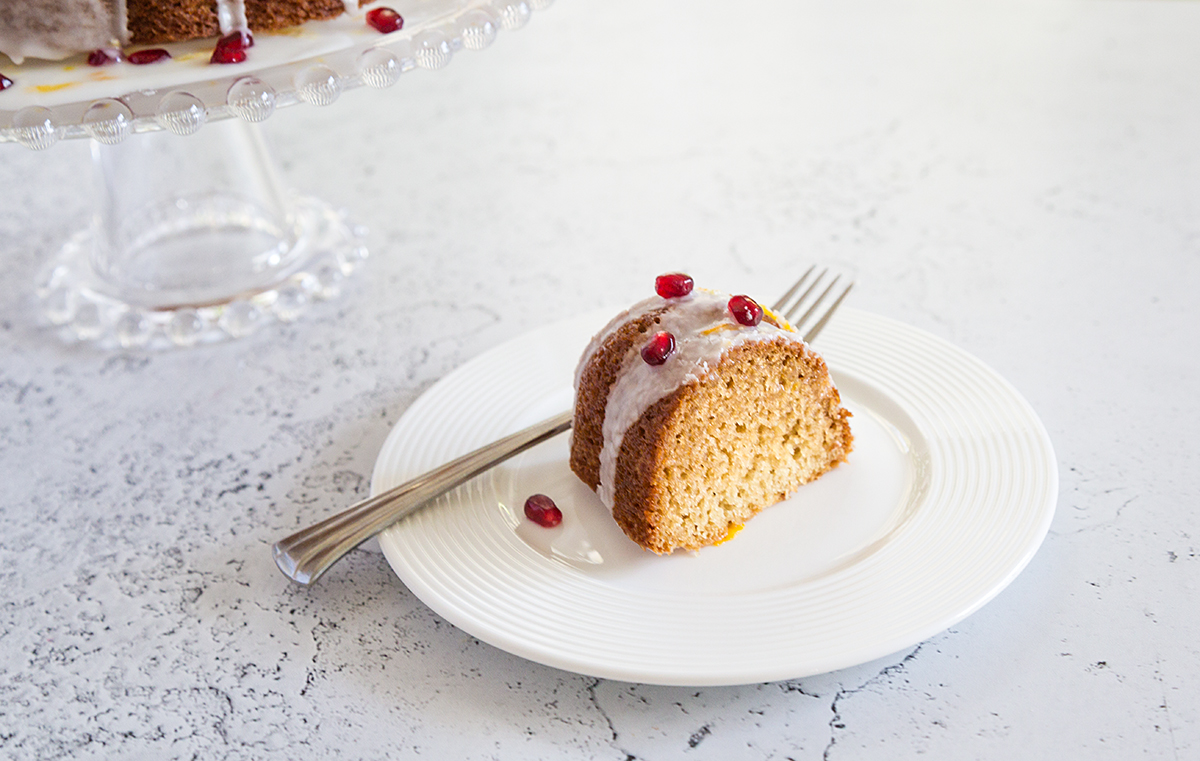
Lemon Drizzle Cake isn’t usually topped with pomegranate seeds or arils, but I wanted my cake to look especially festive for the holiday season. They’re completely optional, but I was surprised how much I enjoyed their tart crunch with a sweet bite of cake.
Want more plant-based Holiday goodies? Be sure to check out all my Holiday recipes, especially the desserts!
I wish you all a happy holiday season. I promise that I will be back with more new recipes soon.
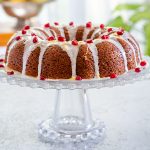
The post Vegan Lemon Drizzle Cake appeared first on FatFree Vegan Kitchen.